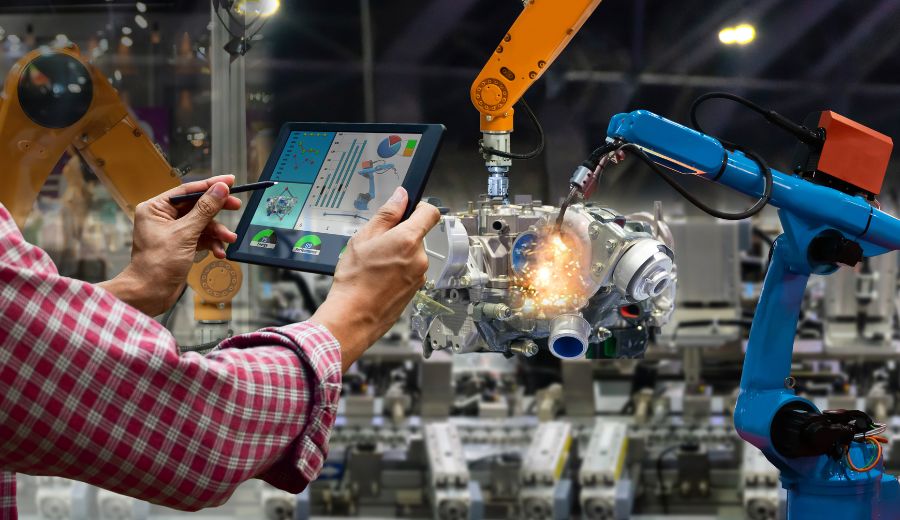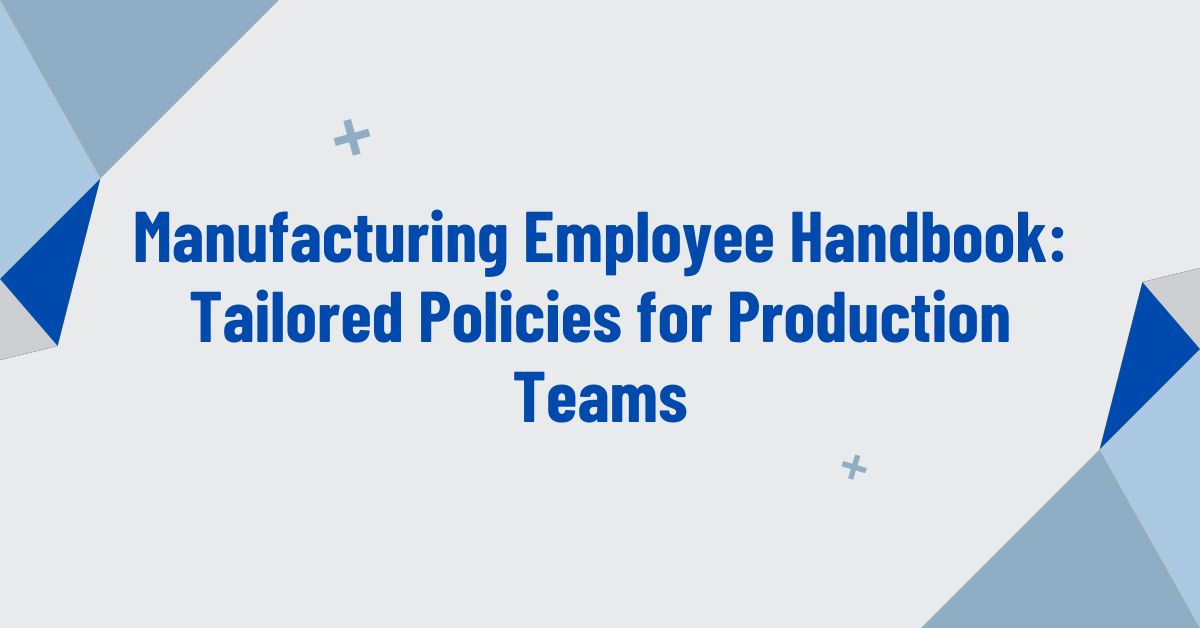The manufacturing industry is vital for economic growth and innovation. It involves various processes and products, exemplified by pioneers like Henry Ford. Many manufacturers follow strict regulations set by the Occupational Safety and Health Administration (OSHA) to ensure workplace safety and operational excellence.
To manage production complexities, a well-structured employee handbook is essential. This guide covers different types of manufacturing and key industry roles.
Customize your employee handbook to match your culture and legal requirements. This ensures a productive and compliant workforce that adheres to manufacturing policies and safety protocols.
Key Takeaways
The manufacturing industry has a significant impact on the global economy.
Overview of the Manufacturing Industry

The manufacturing industry includes various processes that turn raw materials into finished products, covering sectors like automotive, textiles, and electronics. This industry plays a key role in the economy, providing many jobs while adhering to strict OSHA regulations for safety, quality control, and employee training. Manufacturers prioritize operational excellence and conduct regular equipment inspections, ensuring production is efficient and safe. They maintain a strong commitment to workplace safety and regulatory compliance, following guidelines set by entities such as the Society for Human Resource Management and the Equal Employment Opportunity Commission.
What are the Different Types of Manufacturing?
Manufacturing can focus on durable goods, like vehicles, or non-durable goods, like food products. Each type addresses specific market needs using distinct operational strategies. Discrete manufacturing produces distinct items, such as automobiles and electronics. Assembly lines handle units that can be individually counted and tracked. Process manufacturing involves goods that cannot be separated into distinct units, like chemicals or food products, and relies on continuous operations.
Each manufacturing type has unique characteristics related to equipment operation, workforce management, and handling hazardous materials. Operators must be knowledgeable about safety protocols, including documents that provide information on handling chemicals safely and standard procedures to maintain efficiency and compliance, especially to mitigate work-related injuries.
What are the Key Roles in a Manufacturing Company?
Key roles in a manufacturing company include operators, quality control inspectors, and safety trainers. Each contributes to production and ensures compliance with safety protocols and manufacturing policies. Operators run machinery, ensuring machine guarding is in place, and oversee the manufacturing process. This affects both production efficiency and product quality. Quality control inspectors carefully check finished products and raw materials for defects, ensuring they meet industry standards. This helps reduce waste and improve customer satisfaction, while supporting continuous improvement in manufacturing companies. Safety trainers teach employees the procedures from the employee handbook, ensuring everyone understands safety measures to reduce workplace hazards. Operators and quality inspectors collaborate closely, using feedback from each other to adjust processes and foster a culture of awareness, ensuring all staff recognize the importance of safety to maintain a safe work environment.
Importance of Employee Handbooks for Manufacturing Companies
An employee handbook is a crucial resource for manufacturing companies. It details key policies, safety protocols, and training programs needed to maintain a safe and efficient workplace, promoting a culture of safety and regulatory compliance. These handbooks foster a safe work environment, significantly contributing to overall operational success.
Key Policies for Production Teams

Key policies for production teams in manufacturing companies focus on workplace safety, attendance, employee conduct, and ongoing training. These measures ensure all team members adhere to established protocols.
Workplace Safety and Health Policies
Workplace safety and health policies are essential in manufacturing settings to reduce risks from hazardous materials. They ensure proper incident reporting and require the use of Personal Protective Equipment (PPE) for employee protection.
Effective hazard communication is vital. It ensures workers are aware of the dangers related to the substances and equipment they use daily. Emergency response protocols provide clear instructions on how to respond to incidents, reducing panic and ensuring a quick recovery.
Training programs are crucial for reinforcing these policies. They provide employees with the knowledge and skills to manage risks confidently. Regular drills and refresher courses promote best practices and create a safe workplace, allowing teams to work together while prioritizing their well-being.
Attendance and Punctuality Policies
Attendance and punctuality policies are crucial for maintaining efficiency in manufacturing teams. These policies ensure all employees understand expectations for attendance and timeliness.
Detailed in the employee handbook, these policies promote accountability and create a culture of reliability among team members. They cover important aspects such as attendance tracking, reporting absences, and the consequences of non-compliance.
Focusing on these areas boosts productivity and enhances teamwork. Consistent attendance reduces disruptions and keeps projects moving forward. Emphasizing punctuality also supports workplace safety by aligning schedules and ensuring smooth operations.
Clear policies lead to employees fulfilling their responsibilities, contributing to employee development and fostering a positive workplace environment.
Performance and Conduct Policies
Performance and conduct policies in manufacturing are vital for defining acceptable employee behavior and ensuring compliance with workplace standards.
These policies help create a positive workplace culture, enabling employees to understand their roles and responsibilities clearly. By detailing acceptable behaviors and performance metrics, businesses set the groundwork for accountability and mitigate conflicts.
Training programs are essential in providing employees with the knowledge and skills to meet these standards. Regular training sessions reinforce desired behaviors, reduce the chance of violations, and foster a more harmonious and productive work environment.
Training and Development Policies
Training and development policies aim to equip employees with the skills and knowledge needed to work safely and effectively, focusing on safety training and ongoing improvement.
These policies form the foundation of onboarding programs that introduce new hires to the organization's safety procedures and operational practices. Including regular safety training sessions ensures employees stay alert and prepared for potential hazards. Performance assessments help identify skill gaps and promote professional growth.
Together, these efforts improve individual skills and build a workplace culture centered on continuous improvement and operational excellence, leading to greater organizational success.
Leave and Time Off Policies
Leave and time off policies are essential for providing employees in manufacturing companies with a work-life balance. These policies outline the types of leave available and the process for requesting them.
They typically include sick leave, vacation days, and unpaid leave, each serving specific purposes vital for maintaining a healthy workforce. Sick leave allows employees to recover from illnesses without worrying about job security, while vacation time supports mental rejuvenation and overall productivity.
These leave types boost employee morale and contribute to job satisfaction and retention. A well-structured leave policy enhances workplace safety, as employees taking their designated time off are less likely to experience burnout, leading to fewer accidents and more focused work.
Compensation and Benefits Policies
Compensation and benefits policies are crucial for attracting and retaining talent in the manufacturing sector. They ensure employees receive fair pay and promote safety through health benefits.
Conclusion
In conclusion, these policies play a vital role in maintaining a safe and productive workplace. By prioritizing workplace safety, attendance, performance standards, training, leave policies, and compensation, manufacturing companies can foster a culture of excellence and commitment among their employees.
Creating an Effective Employee Handbook for Manufacturing

These policies offer financial incentives and promote a positive work environment, boosting employee morale. When employees feel valued through comprehensive compensation packages, like performance bonuses and health insurance, they tend to remain loyal to their employers.
Improving workplace safety with well-designed programs demonstrates a commitment to employee well-being. This approach can significantly reduce turnover rates. By examining these details, organizations can create a strategy that combines financial incentives with a culture of safety, ultimately enhancing staff satisfaction and commitment.
Customizing the Employee Handbook for Your Manufacturing Company
Customizing the employee handbook for a manufacturing company is essential to reflect unique culture, values, and operational needs. This ensures alignment with specific policies and practices.
Understanding Company Culture and Values
Understanding company culture and values is crucial when creating an employee handbook. This alignment ensures that the policies resonate with the workforce and promote a unified work environment.
By aligning the employee handbook with core principles, the company fosters employee unity and establishes a foundation for operational excellence. This approach communicates a commitment to safety training and employee growth, creating an environment where individuals feel valued and motivated.
This alignment boosts engagement as employees can relate daily tasks to the company's broader vision and mission. It highlights the importance of a supportive culture in achieving shared goals through adherence to manufacturing policies and safety protocols.
Consulting with Production Team Leaders
Consulting with production team leaders is vital when customizing the employee handbook. They provide practical insights on policies and procedures affecting daily operations, including equipment operation and hazard communication.
This collaboration ensures that the employee handbook aligns with workplace realities. By involving team leaders, organizations gather crucial feedback to ensure policies are practical and address specific challenges, such as machine guarding and incident reporting.
Their input is also essential for maintaining regulatory compliance. Leaders can suggest necessary changes to meet new standards set by OSHA and other regulatory bodies. This strengthens the organization's commitment to an effective safety culture and compliant operations.
Incorporating Legal Requirements and Regulations
Including legal requirements and regulations, such as OSHA guidelines and those from the Equal Employment Opportunity Commission, is crucial when creating an employee handbook. This ensures compliance and protects both employees and the organization.
It's important to cover various legal frameworks affecting manufacturing, such as state-specific environmental laws and machinery safety regulations. By integrating safety standards and labor laws into the handbook, organizations promote a culture of safety and fairness among workers.
This proactive approach reduces the risk of workplace accidents, injuries, and legal issues, while also boosting employee morale and productivity. Clearly outlining these regulations allows employees to understand their rights and responsibilities, leading to a more informed workforce.
Updating and Communicating the Manufacturing Employee Handbook

Regularly updating and clearly communicating the manufacturing employee handbook is crucial. This ensures all employees are aware of current policies, procedures, and safety protocols, including emergency response and evacuation plans.
Regular Review and Revision Process
Regularly reviewing and revising the employee handbook is important for keeping it compliant with regulations from the National Labor Relations Board and aligned with company policy changes. This ongoing process involves key steps to ensure effectiveness.
Prioritizing these updates allows organizations to create a reliable and engaging resource for employees, reinforcing a culture of safety and compliance.
Gathering Stakeholder Input
Effective training and orientation programs for new and current employees are essential for ensuring they understand the employee handbook and workplace safety protocols. These programs establish a foundation for promoting safety and compliance within the organization, equipping employees with the knowledge to manage potential hazards and follow company policies.
Integrating safety training into the orientation process helps employees learn their responsibilities and contribute positively to the work environment. Regular workshops and refresher courses enhance understanding and retention of important guidelines, making safety a priority at all levels.
Training Programs for Employees
Ensuring adherence to the employee handbook policies is crucial for maintaining safety, efficiency, and regulatory standards in manufacturing environments. Organizations should establish clear accountability structures to outline individual responsibilities and expectations, emphasizing the importance of following safety protocols regarding hazardous materials.
Regular training sessions educate employees on standards and promote their development through structured programs. Using feedback mechanisms like anonymous surveys helps management assess the effectiveness of safety training and employees' understanding of policies related to workplace ergonomics.
Audits and reviews identify gaps in compliance, enabling proactive adjustments to training sessions and operations. By fostering a culture of accountability and continually evaluating enforcement strategies, organizations can prioritize safety and efficiency.
Frequently Asked Questions
What is the purpose of a Manufacturing Employee Handbook?
The Manufacturing Employee Handbook serves as a guide outlining the policies and procedures specific to our production teams, providing employees with clear expectations regarding workplace conduct, safety, and job performance.
Are the policies in the Manufacturing Employee Handbook different from those in the company's general handbook?
Yes, the Manufacturing Employee Handbook contains tailored policies specific to our production teams, addressing their unique needs and responsibilities.
Can I request changes or additions to the policies in the Manufacturing Employee Handbook?
Yes, if you believe a policy should be added or modified, submit a request to your supervisor or the human resources department. All requests will be carefully considered, and necessary updates will be made to the handbook.
Is it mandatory for all production team members to read and understand the Manufacturing Employee Handbook?
Yes, all employees must read and understand the policies outlined in the Manufacturing Employee Handbook to ensure a safe and productive work environment. If you have questions or concerns, please speak with your supervisor or the human resources department.
Are there consequences for not following the policies outlined in the Manufacturing Employee Handbook?
Yes, failure to comply with the policies may result in disciplinary action, up to and including termination of employment. It is important to familiarize yourself with the policies and follow them to avoid any consequences.
Is the Manufacturing Employee Handbook subject to change?
Yes, the Manufacturing Employee Handbook can change as company needs and regulations evolve. It's important to regularly review the handbook to stay informed of any changes that may affect you. If you have questions about these changes, please don't hesitate to ask for clarification.

